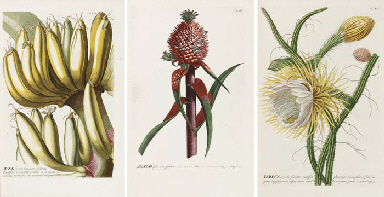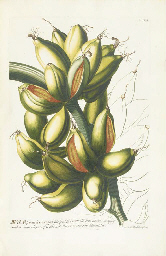TREW, Christoph Jakob (1695-1769). Hortus Nitidissimis omnem per annum superbiens floribus, sive amoenissimorum florum imagines... Der das ganze Jahr hindurch im schoensten Flohr stehende Blumen-Garten oder Abbildungen der lieblichsten Blumen... Edited by Johann Michael Seligmann (vol. I) and Adam Ludwig Wirsing (vols. II and III). Nuremberg: Fleischmann (vol. I), and Adam Ludwig Wirsing (vol. II and III), 1750-1768-1772-1786. 3 volumes bound in 4, large 2 o (548 x 380 mm). 178 hand-colored etched and engraved plates on (number 1-180 with 60/61 and 121/122 combined on one plate), some printed in colors, by J.M. Seligman, J.M. Stock and A.L. Wirsing after G.D. Ehret, G.W. Baurenfeind, B.R. and M.B. Dietschin, N.F. Eisenberger, J.C. Keller and others. Parallel text in Latin and German in two columns. (Only title and index of third volume, text missing, plates 60-180 water damaged with some offsetting and bleeding of colors.) Volume with plates 1-59 in contemporary deer skin and boards, rest bound in modern red half morocco. Provenance : Massachusetts Horticultural Society, Stickney Fund (bookplate, dated 1889). FIRST EDITION. According to Stafleu the relevant text was not published simutaneously with the plates, and therefore it is no surprise that the text for plates 120-180 is missing in this set. There are 178 plates (number 1-180, with 60/61 and 121/122 combined on two larger plates) published between 1750 and 1786. The accompanying text to plates 1-59 (printed between 1750 and 1767) was published in 1756 and 1768 (probably actually 1767). The text for plates 60-120 (1767-1774) came out in 1772 and the text for plates 121-180 (1775-1786) was published in 1786 (here missing). A rare set of a work described by Dunthorne as 'one of the finest records of the cultivated flowers of the period' and by Blunt (p. 166) as 'one of the most decorative florilegia of the mid-eighteenth century.' The work contains full sized colored illustrations of Hyacinths, Tulips (over 20 plates), Ranunculi, Anemones, Caryophylli, Lilies, Auriculas, Roses, Narcissi, Iris, Cheiranthi, Asters, Fritillaries, and Crown Imperials. The great characteristic of the beautiful plates is the way in which the watercolor and bodycolor painting almost entirely eclipses the engraved lines. Although the work was actually started by Seligmann, the engravings were based on the collection of flower drawings owned by the botanist and bibliophile Christoph Trew, a distinguished physician of Nuremberg. Georg Ehret (1708-1770), who enjoyed Trew's patronage from 1732 and travelled widely on his behalf before settling in London in 1736, produced the designs for 40 plates. The remainder were drawn up by a team of local artists, including J.C. Keller, Professor of Drawing at Erlangen University, and the court painter Nikolaus Eisenberger. There seems to be some confusion about the number of plates this work is supposed to have: Brunet V:943 (calls for 190 plates); Dunthorne 310 (180 plates, actually 178); Great Flower Books p. 78 (180 plates, plates 60/61 and 121/122 are represented by one plate each); Johnston Cleveland Collections 493 (190 plates); Nissen BBI 1995 (180 plates, 60/61 and 121/122 each on one plate, referance to Tjaden with 190 plates); Pritzel 9500 (180 plates); Stafleu and Cowan TL2 15.130 (180 plates, with reference to Tjaden with 190 plates).
TREW, Christoph Jakob (1695-1769). Hortus Nitidissimis omnem per annum superbiens floribus, sive amoenissimorum florum imagines... Der das ganze Jahr hindurch im schoensten Flohr stehende Blumen-Garten oder Abbildungen der lieblichsten Blumen... Edited by Johann Michael Seligmann (vol. I) and Adam Ludwig Wirsing (vols. II and III). Nuremberg: Fleischmann (vol. I), and Adam Ludwig Wirsing (vol. II and III), 1750-1768-1772-1786. 3 volumes bound in 4, large 2 o (548 x 380 mm). 178 hand-colored etched and engraved plates on (number 1-180 with 60/61 and 121/122 combined on one plate), some printed in colors, by J.M. Seligman, J.M. Stock and A.L. Wirsing after G.D. Ehret, G.W. Baurenfeind, B.R. and M.B. Dietschin, N.F. Eisenberger, J.C. Keller and others. Parallel text in Latin and German in two columns. (Only title and index of third volume, text missing, plates 60-180 water damaged with some offsetting and bleeding of colors.) Volume with plates 1-59 in contemporary deer skin and boards, rest bound in modern red half morocco. Provenance : Massachusetts Horticultural Society, Stickney Fund (bookplate, dated 1889). FIRST EDITION. According to Stafleu the relevant text was not published simutaneously with the plates, and therefore it is no surprise that the text for plates 120-180 is missing in this set. There are 178 plates (number 1-180, with 60/61 and 121/122 combined on two larger plates) published between 1750 and 1786. The accompanying text to plates 1-59 (printed between 1750 and 1767) was published in 1756 and 1768 (probably actually 1767). The text for plates 60-120 (1767-1774) came out in 1772 and the text for plates 121-180 (1775-1786) was published in 1786 (here missing). A rare set of a work described by Dunthorne as 'one of the finest records of the cultivated flowers of the period' and by Blunt (p. 166) as 'one of the most decorative florilegia of the mid-eighteenth century.' The work contains full sized colored illustrations of Hyacinths, Tulips (over 20 plates), Ranunculi, Anemones, Caryophylli, Lilies, Auriculas, Roses, Narcissi, Iris, Cheiranthi, Asters, Fritillaries, and Crown Imperials. The great characteristic of the beautiful plates is the way in which the watercolor and bodycolor painting almost entirely eclipses the engraved lines. Although the work was actually started by Seligmann, the engravings were based on the collection of flower drawings owned by the botanist and bibliophile Christoph Trew, a distinguished physician of Nuremberg. Georg Ehret (1708-1770), who enjoyed Trew's patronage from 1732 and travelled widely on his behalf before settling in London in 1736, produced the designs for 40 plates. The remainder were drawn up by a team of local artists, including J.C. Keller, Professor of Drawing at Erlangen University, and the court painter Nikolaus Eisenberger. There seems to be some confusion about the number of plates this work is supposed to have: Brunet V:943 (calls for 190 plates); Dunthorne 310 (180 plates, actually 178); Great Flower Books p. 78 (180 plates, plates 60/61 and 121/122 are represented by one plate each); Johnston Cleveland Collections 493 (190 plates); Nissen BBI 1995 (180 plates, 60/61 and 121/122 each on one plate, referance to Tjaden with 190 plates); Pritzel 9500 (180 plates); Stafleu and Cowan TL2 15.130 (180 plates, with reference to Tjaden with 190 plates).

.jpg)




.jpg)




Try LotSearch and its premium features for 7 days - without any costs!
Be notified automatically about new items in upcoming auctions.
Create an alert